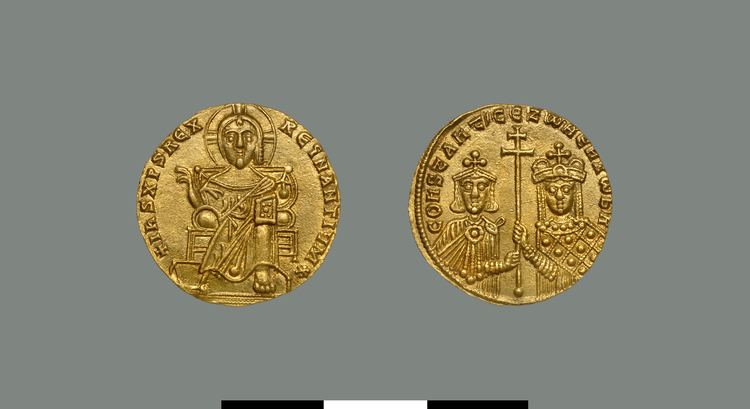Died after 919 Grandchildren Romanos II | Name Zoe Karbonopsina | |
 | ||
Reign 9 January 906 – 11 May 912 Children Constantine VII Porphyrogenitus, Emperor of the East Great grandchildren Basil II, Anna Porphyrogenita, Constantine VIII Similar People Constantine VII Porphyro, Leo VI the Wise, Basil I, Michael III | ||
Zoe Karbonopsina, also Karvounopsina or Carbonopsina, i.e., "with the Coal-Black Eyes" (Greek: Ζωή Καρβωνοψίνα, Zōē Karbōnopsina), was an empress consort and regent of the Byzantine empire. She was the fourth spouse of the Byzantine Emperor Leo VI the Wise and the mother of Constantine VII, serving as his regent from 914 until 919.
Contents

Early life
Zoe Karbonopsina was a relative of the chronicler Theophanes the Confessor and a niece of the admiral Himerios. Desperate to sire a son, Leo VI married his mistress Zoe on 9 January 906, only after she had given birth to the future Constantine VII at the end of 905. However, this constituted his fourth marriage, and was therefore un-canonical in the eyes of the Eastern Orthodox Church, which had already been reluctant to accept his third marriage to Eudokia Baïana, who died in childbirth in 901.
Although the Patriarch Nicholas Mystikos reluctantly baptised Constantine, he forbade the emperor from marrying for the fourth time. Leo VI married Zoe with the assistance of a cooperative priest, Thomas, but Nicholas' continued opposition to the marriage led to his removal from office and replacement by Euthymios in 907. The new patriarch attempted a compromise by defrocking the offending priest but recognizing the marriage.
Rise to Power
When Leo died in 912, he was succeeded by his younger brother Alexander, who recalled Nicholas Mystikos and expelled Zoe from the palace. Shortly before his death Alexander provoked a war with Bulgaria. She returned on Alexander's death in 913, but Nicholas forced her to enter the convent of St. Euphemia in Constantinople after obtaining the promise of the senate and the clergy not to accept her as empress. However, Nicholas' unpopular concessions to the Bulgarians later in the same year weakened his position and in 914 Zoe was able to overthrow Nicholas and replace him as regent. Nicholas was allowed to remain patriarch after reluctantly recognizing her as empress.
Reign
Zoe governed with the support of imperial bureaucrats and the influential general Leo Phokas the Elder, who was her favorite. Zoe's first order of business was to revoke the concessions to Simeon I of Bulgaria, including the recognition of his imperial title and the arranged marriage between his daughter and Constantine VII. This renewed the war with Bulgaria, which began badly for the Byzantines who were distracted by military operations in Southern Italy and on the eastern frontier. In 915 Zoe's troops defeated an Arab invasion of Armenia, and made peace with the Arabs. This freed her hands to organize a major expedition against the Bulgarians, who had raided deep into Byzantine Thrace and captured Adrianople. The campaign was planned on a grand scale, and intended the bribing and transportation of Pechenegs into Bulgaria by the imperial fleet from the north. However, the Pecheneg alliance failed, and Leo Phokas was crushingly defeated in the Battle of Anchialus and again at Katasyrtai in 917. Zoe tried to ally with Serbia and the Magyars against Simeon. This also failed to produce any concrete results, and the Arabs, encouraged by the empire's weakness, renewed their raids. A humiliating treaty with the Arabs of Sicily, who were asked to help subdue revolts in Italy, did little to improve the position of Zoe and her supporters.
Overthrowing
In 919, there was a coup involving various factions, but the opposition to Zoe and Leo Phokas prevailed; in the end the admiral Romanos Lekapenos took power, married his daughter Helena Lekapene to Constantine VII, and forced Zoe back into the convent of St. Euphemia.
